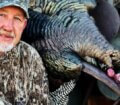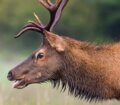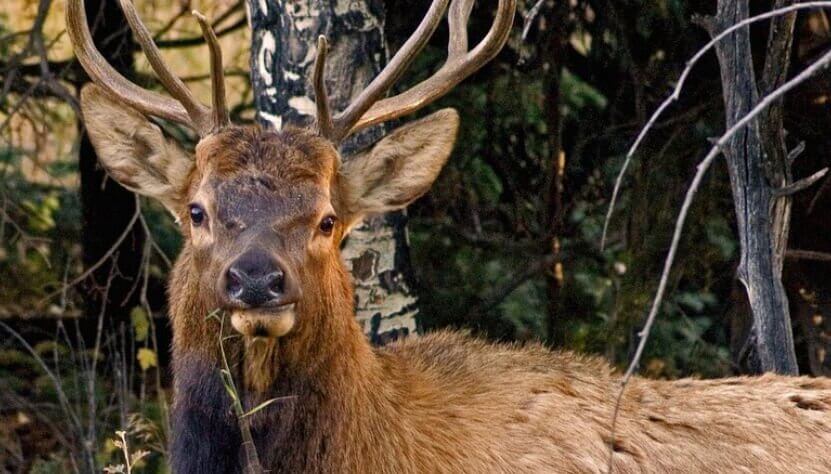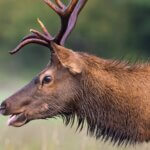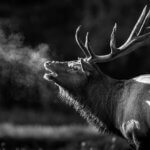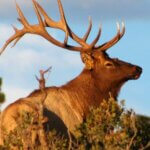Editor’s Note: Eddie Salter of Evergreen, Alabama, is known as Mr. Turkey – a title that speaks to his reputation of having won hundreds of turkey-calling contests and having had so-much success hunting gobblers. He’s also created turkey calls and sold them. Salter’s style of hunting is being aggressive. When he hears a turkey gobble, he wants to go to the tom and get as close as possible before taking him. Salter has learned that being a good turkey caller can make you a good elk hunter. (All artwork this week is courtesy of Dallen Lambson of Pocatello, Idaho, who’s won numerous awards, and has his artwork featured in Bass Pro Shops and Cabela’s stores.
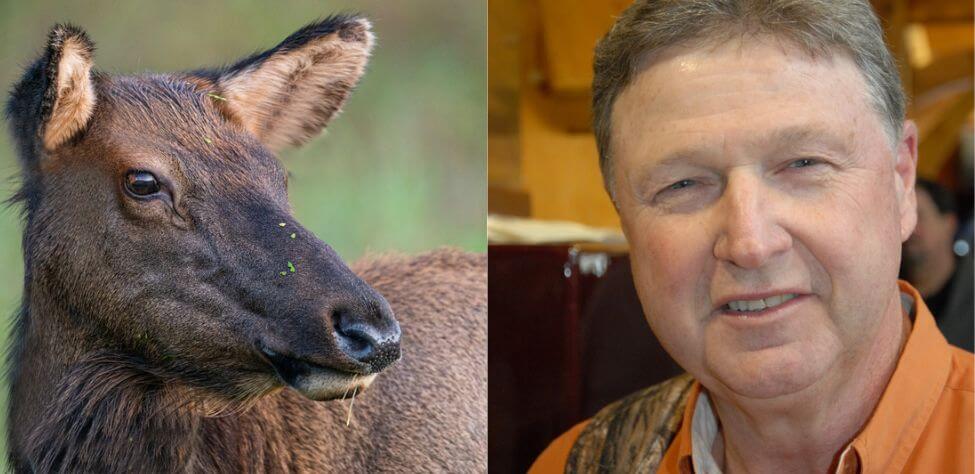
My first elk hunt in the early 1990s in Arizona is my most memorable. I was told by most everyone I knew, “You won’t get a tag to hunt elk the first year you apply. More than likely, you’ll have to put in for a tag in Arizona every year. Maybe by the sixth year, you’ll draw a tag.” However, I was lucky enough to get an elk tag the first year I put in for it. I was a member of the Bear Archery Pro staff at that time and spent a lot of time with the guys on staff. One of the guys on staff was a cook who also guided for elk in Arizona. He told me I should put in to hunt Unit 3. He said that if I were to draw that unit, I’d, “Stand a real-good chance of taking an elk.”
We slept in a sheepherder’s canvas tent in Arizona. I was terrified the first night when a lightning rainstorm arrived. The tent was under some big ponderosa pines. The lightning was hitting all around us. I stayed up for half the night – although the storm only lasted for about an hour. As soon as the storm passed, we heard elk bugling all night long – a good wake-up call for me.
The first morning we heard elk all around us but seemed to never be able to get them to come to us. My guide, Cliff White, bugled and cow-called, and the elk would answer. However, they wouldn’t come into bow range. Back in the early 90s, I wanted to take an elk as bad as a man can – I had blood in my eyes. I told Cliff, “You stay behind me and keep the bull bugling. I’ll move in on the elk and try to see him.”
I went down in the canyon about 150-200 yards from Cliff. As I tried to reach the elk, I looked down to where I saw a big tree flopping back and forth in the wind. I wasn’t too deep into the canyon that had some fairly-open spots but was mostly timber. As I continued moving into the canyon, I saw where elk had been hooking trees with their antlers. So, I knew that we were near some good-sized elk. Then, I heard Cliff’s bugle, the tree stopped flopping, and I heard a bull bugle right at the tree. I got within 40 yards of the bull and watched him rake his antlers on the tree. I could have made the shot, but all I could see was his rump.
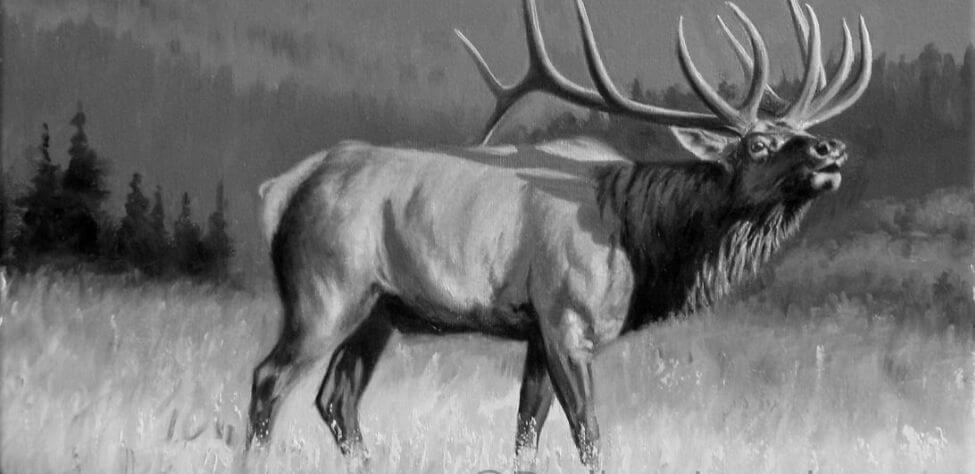
Once the bull finally turned a little to his left side, I still didn’t have a good shot. Then a cow spooked that elk. I was close to where the bull was at the tree. I was about to have a heart attack. The cow ran five steps from me, and I never had seen an animal that big (A cow elk weighs about 500 pounds and stands 4-1/2 feet tall). I didn’t know if she would run over me or what. But she finally spotted me and turned away. She gave a high-pitched call. My bull with the huge antlers left on a dead run. He was one that I would have loved to have had on my wall.
Cliff and I moved on, and we tried to call some other elk. At one point, Cliff said, “Let’s let the bull settle down for now, and hopefully he’ll be back in the morning. We’ll return then.” We continued to hunt other elk and crossed a few more canyons. We had another bull bugling, but he wouldn’t come to us. I had ants in my pants about getting to that bull. I thought, “If I could sneak up on that bull this morning and could have taken a shot, then surely, I could sneak-up on another one. This elk hunting is not that much different from turkey hunting. With turkey hunting, I’ve learned that sometimes you can call in the turkey, and sometimes you can’t.”
Tomorrow: More about Salter’s First Elk Hunting Day
Expert Guidebooks on Elk Hunting: Best Sellers

Secrets for Hunting Elk
The quickest, easiest (if there is an easy way), and safest way to find and take that bull elk of a lifetime will be to hunt with a guide.
Chad Schearer, a longtime Montana guide and TV personality, told me, “My hunter is my gun. If I get to the elk, and my hunter isn’t with me, then we don’t take the elk. My job is not only to find the elk but also to help the hunter get to the elk and make the experience as enjoyable as I can for him.” That’s the kind of fella with whom I want to go elk hunting.
An elk hunt can be tough, but it doesn’t have to be so tough that you don’t enjoy it. That’s why this elk hunting book starts with the confessions of an elk guide and with Chad Schearer’s philosophy of what the guide and the hunter’s relationship should be.
A good portion of your success will depend on your physical condition, and Matt Morrett of Harrisburg, Pennsylvania explains how an eastern hunter can get ready physically during June and July to hunt western elk, the animals he describes as, “Like deer or turkeys on steroids.”
Wayne Carlton, well-known elk hunter and TV and video personality from Montrose, Colorado, tells us what types of elk calls to use and what to say to the elk. Mike Miller of Colorado, another elk guide and Mossy Oak video personality, has tactics for the best equipment for bowhunting and gun hunting elk.
You’ll learn helpful strategies and hunting tips in this book, as well as some straightforward hunting methods that will help to make your elk hunt more successful.
“Thanks to the advice in your elk hunting books, I was able to call up a nice 6-point (6X6) bull elk! He was bugling like crazy. I called him in from about a ¼ mile away. Called him into bow range (about 40 yards away). It was a thrill!” ~Rob Brannon
VERSIONS: AUDIBLE & KINDLE

Elk: Keys to 25 Hunters’ Success
Often just one tip or tactic makes the difference in whether you take an elk home to dinner or have to hike back to the truck by yourself. In John E. Phillips’ latest elk book, Elk: Keys to 25 Hunters’ Success, you’ll learn from successful elk hunters the strategies they use to find and take elk.
Many know that the technique that seems to work most often is to hunt where other elk hunters don’t and understand where the elk are before you go on a hunt by studying data from each state, visiting HuntData (see chapter 1), examining maps, and reading postings on elk forums.
This book also tells you how to get ready physically for an elk hunt, including participating in Train to Hunt Competitions, what gear you need to take, how to enjoy a successful do-it-yourself elk hunt, or how to pick the best elk guide for you. You’ll also hear about the X System and the Broken Y System of hunting elk.
Although no one person has all the answers on how to help you find and take your elk, I’m convinced that this book’s outdoors men and women will teach you how to have satisfying elk hunts.
As my friend Karl Badger once told me, “Elk hunting doesn’t get any better than when I ride horses into the high backcountry, see two grizzly bears, hear a pack of wolves howl close to camp all night long, eat plenty of delicious food prepared on a fire and enjoy the company of good friends.”
VERSIONS: AUDIBLE, KINDLE & PRINT

How to Find Your Elk and Get Him in Close will teach you the tactics of 10 nationally known elk hunters, to help put that giant bull that’s been screaming at you from afar, in your lap. You’ll learn what some of the best guides, outfitters, and successful elk hunters do to find elk and get them in really close.
Also in this audiobook, you’ll notice that the majority of the experts call elk to within bow range. We selected numerous bowhunters and bowhunting guides, since the bowhunter has to get much closer to a bull than the gun hunter does – often less than 20 or 30 yards – practically in your lap.
On one elk hunt, I’d heard this bull bugle all morning. My guide had called him within 30 yards, and he was standing just inside black timber. I saw the smoke from his nose wafting out into the icy air less than 30-yards away. All the bull had to do was step out, and I could take the shot with my bow. But then, through no fault of my guide or me, the bull vanished.
The only conclusion I could come up with to understand why the bull I wanted to take with my bow hadn’t stepped out and given me a shot, was because he got raptured. He evidently had left the earth with no trace of himself.
This hunt was when I started wanting to learn more about hunting elk up close. In this book, I’ve tried to find some of the most knowledgeable, experienced, and practical elk hunters. I’ve always found that the best way to learn any outdoor skill, is to either hunt or fish with the best sportsmen in that field.
Often, in elk hunting, that means elk guides, who generally hunt every day of the season and receive a salary for every hunter they guide. So, I’ve put together a group of some of the best elk hunters I know to help us all learn how to find bull elk and get them in close.
VERSIONS: AUDIBLE, KINDLE & PRINT

